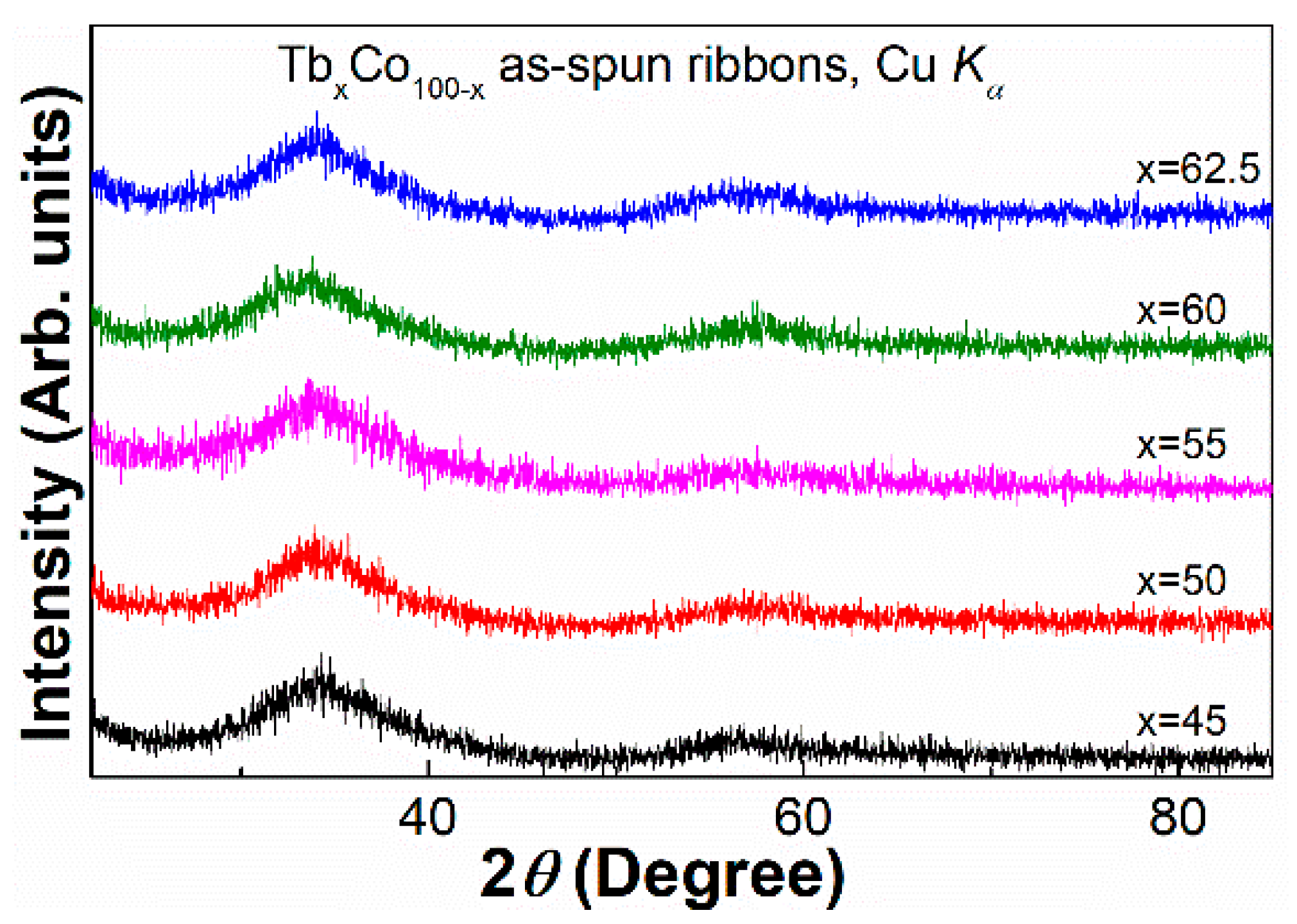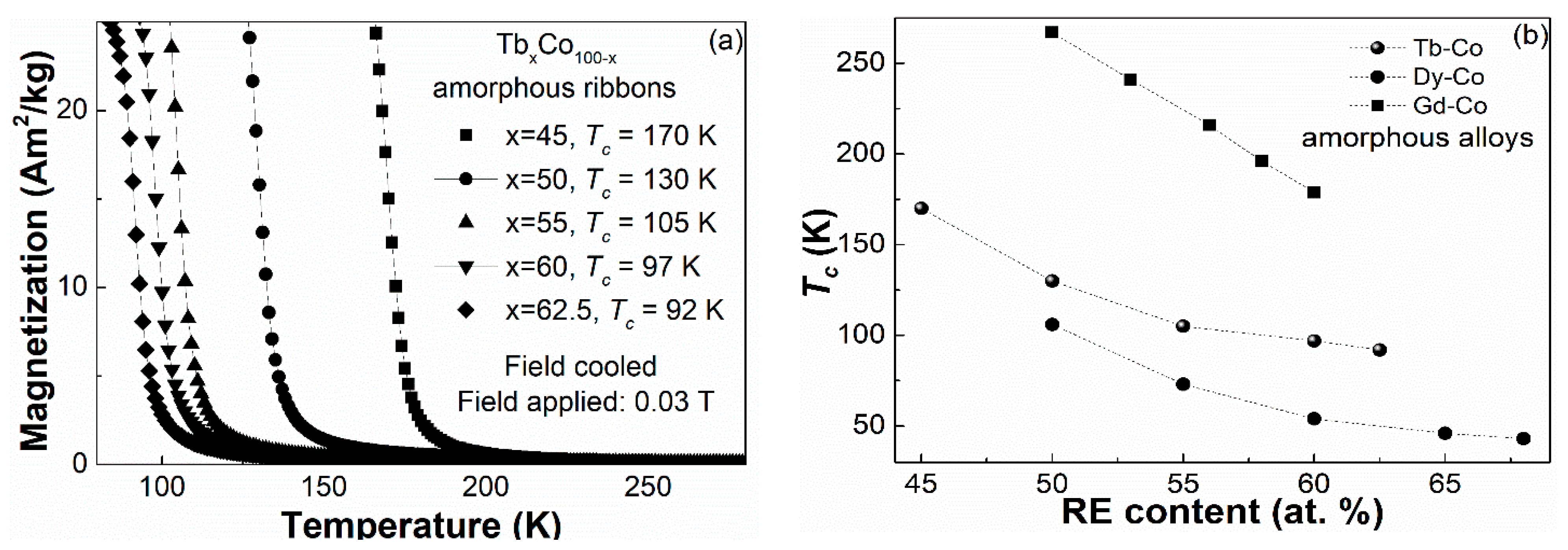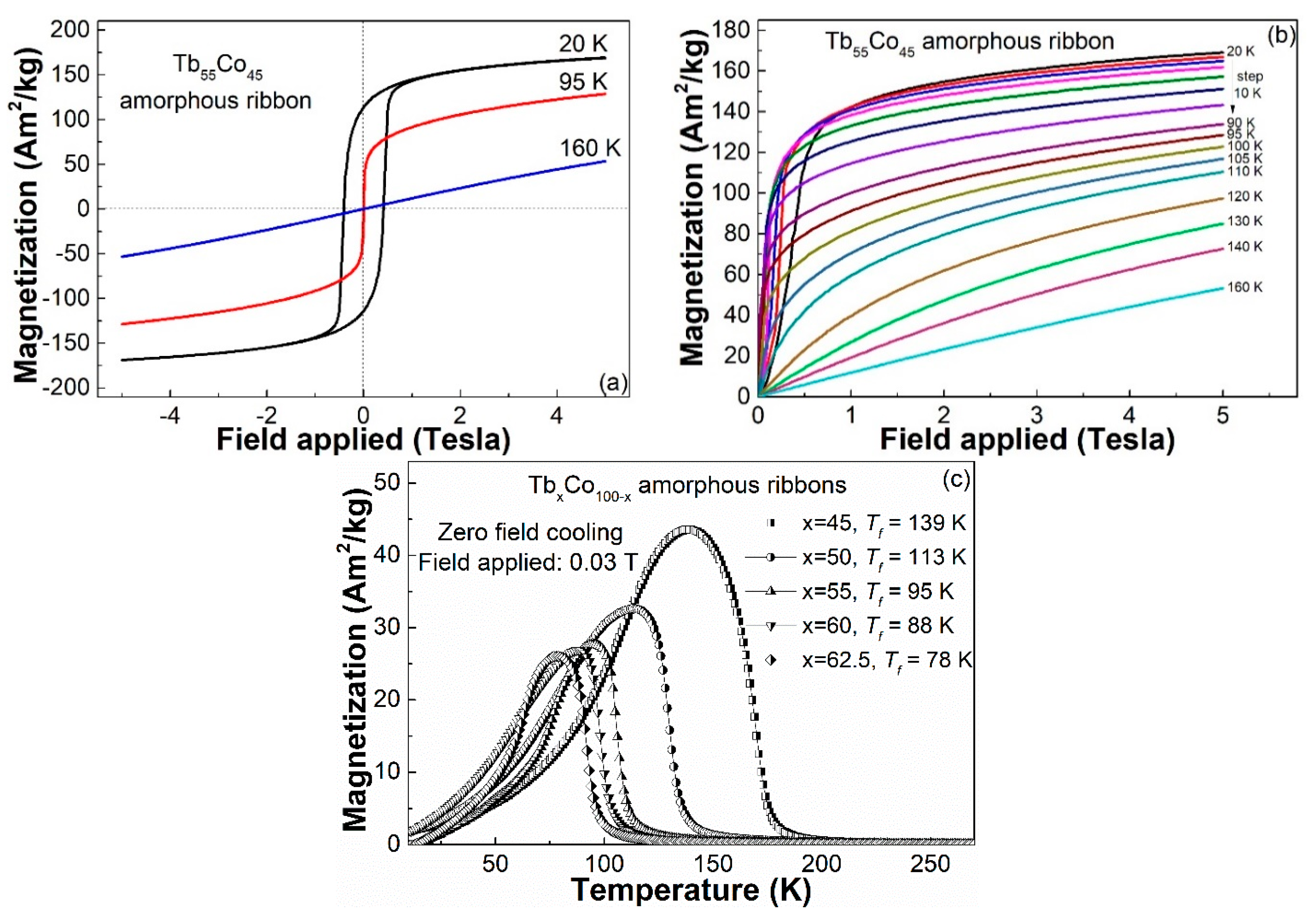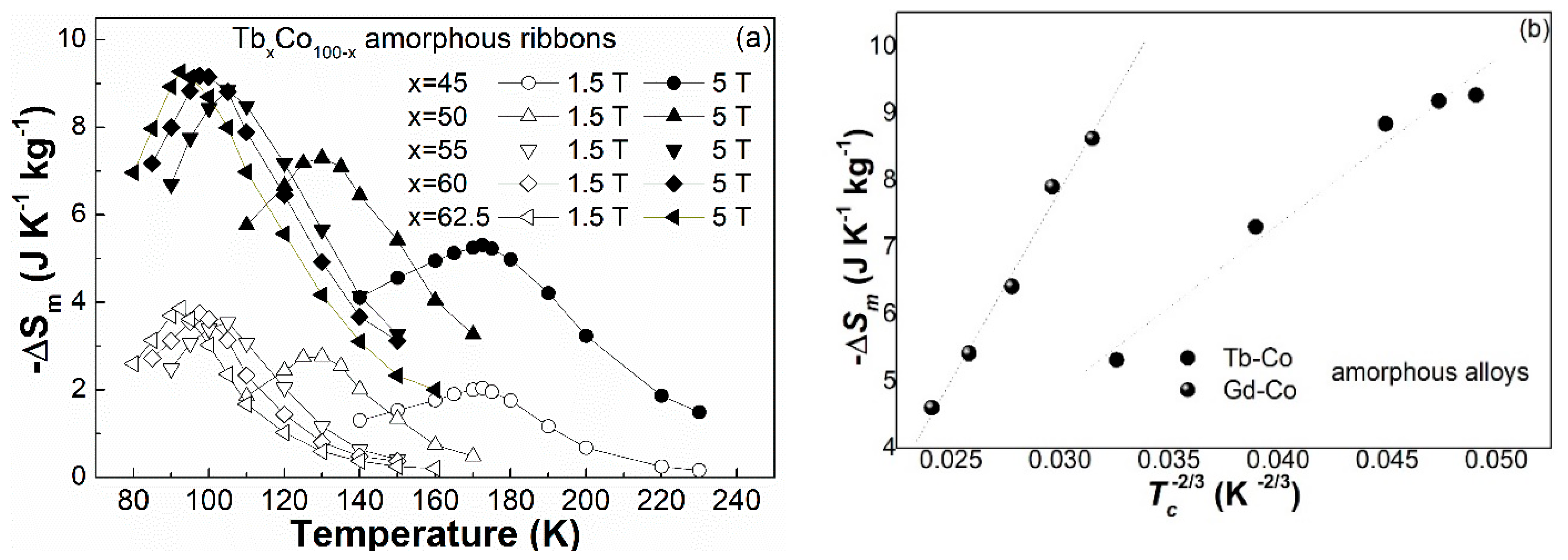Compositional Dependence of Curie Temperature and Magnetic Entropy Change in the Amorphous Tb–Co Ribbons
Abstract
1. Introduction
2. Materials and Methods
3. Results
4. Conclusions
Author Contributions
Funding
Institutional Review Board Statement
Informed Consent Statement
Data Availability Statement
Acknowledgments
Conflicts of Interest
References
- De Oliveira, N.A.; von Ranke, P.J. Theoretical aspects of the magnetocaloric effect. Phys. Rep. 2010, 489, 89. [Google Scholar] [CrossRef]
- Tishin, A.M.; Spichkin, Y.I. The magnetocaloric effect and its applications. Inst. Phys. Bristol. 2003. [Google Scholar] [CrossRef]
- Franco, V.; Blázquez, J.S.; Ipus, J.J.; Law, J.Y.; Moreno-Ramírez, L.M.; Conde, A. Magnetocaloric effect: From materials research to refrigeration devices. Prog. Mater. Sci. 2018, 93, 112–232. [Google Scholar] [CrossRef]
- Gschneidner, K.A.; Pecharsky, V.K. Magnetocaloric materials. Annu. Rev. Mater. Sci. 2000, 30, 387–429. [Google Scholar] [CrossRef]
- Chaudhary, V.; Chen, X.; Ramanujan, R.V. Iron and manganese based magnetocaloric materials for near room temperature thermal management. Prog. Mater. Sci. 2019, 100, 64–98. [Google Scholar] [CrossRef]
- Lai, J.W.; Zheng, Z.G.; Zhong, X.C.; Franco, V.; Montemayor, R.; Liu, Z.W.; Zeng, D.C. Table-like magnetocaloric effect of Fe88−xNdxCr8B4 composite materials. J. Magn. Magn. Mater. 2015, 390, 87. [Google Scholar] [CrossRef]
- Chen, L.S.; Zhang, J.Z.; Wen, L.; Yu, P.; Xia, L. Outstanding magnetocaloric effect of Fe88−xZr8B4Smx (x = 0, 1, 2, 3) amorphous alloys. Sci. China Phys. Mech. Astro. 2018, 61, 056121. [Google Scholar] [CrossRef]
- Ma, L.Y.; Gan, L.H.; Chan, K.C.; Ding, D.; Xia, L. Achieving a table-like magnetic entropy change across the ice point of water with tailorable temperature range in Gd-Co-based amorphous hybrids. J. Alloy. Compd. 2017, 723, 197. [Google Scholar] [CrossRef]
- Liu, G.L.; Zhao, D.Q.; Bai, H.Y.; Wang, W.H.; Pan, M.X. Room temperature table-like magnetocaloric effect in amorphous Gd50Co45Fe5 ribbon. J. Phys. D Appl. Phys. 2016, 49, 055004. [Google Scholar] [CrossRef]
- Tang, B.Z.; Xie, H.X.; Li, D.M.; Xia, L.; Yu, P. Microstructure and its effect on magnetic and magnetocaloric properties of the Co50Gd50-xFex glassy ribbons. J. Non-Cryst. Solids 2020, 533, 119935. [Google Scholar] [CrossRef]
- Wu, C.; Ding, D.; Xia, L.; Chan, K.C. Achieving tailorable magneto-caloric effect in the Gd-Co binary amorphous alloys. AIP Adv. 2016, 6, 035302. [Google Scholar] [CrossRef]
- Tang, B.Z.; Huang, L.W.; Song, M.N.; Ding, D.; Wang, X.; Xia, L. Compositional dependence of magnetic and magnetocaloric properties of the Gd-Ni binary amorphous alloys. J. Non-Cryst. Solids 2019, 522, 119589. [Google Scholar] [CrossRef]
- Xia, L.; Chan, K.C.; Tang, M.B.; Dong, Y.D. Achieving a large adiabatic temperature rise of Gd55Co25Al20 bulk metallic glass by minor Zn addition. J. Mater. Sci. 2015, 50, 1333–1337. [Google Scholar] [CrossRef]
- Yu, P.; Zhang, N.Z.; Cui, Y.T.; Wen, L.; Zeng, Z.Y.; Xia, L. Achieving an enhanced magneto-caloric effect by melt spinning a Gd55Co25Al20 bulk metallic glass into amorphous ribbons. J. Alloy. Compd. 2016, 655, 353–356. [Google Scholar] [CrossRef]
- Fu, H.; Zou, M. Magnetic and magnetocaloric properties of ternary Gd-Co-Al bulk metallic glasses. J. Alloy. Compd. 2011, 509, 4613–4616. [Google Scholar] [CrossRef]
- Zheng, Z.G.; Zhong, X.C.; Su, K.P.; Yu, H.Y.; Liu, Z.W.; Zeng, D.C. Magnetic properties and large magnetocaloric effects in amorphous Gd-Al-Fe alloys for magnetic refrigeration. Sci. China Phys. Mech. Astro. 2011, 54, 1267–1270. [Google Scholar] [CrossRef]
- Zhang, H.Y.; Li, R.; Zhang, L.L.; Zhang, T. Tunable magnetic and magnetocaloric properties in heavy rare-earth based metallic glasses through the substitution of similar elements. J. Appl. Phys. 2014, 115, 133903. [Google Scholar] [CrossRef]
- Fang, Y.K.; Lai, C.H.; Hsieh, C.C.; Zhao, X.G.; Chang, H.W.; Chang, W.C.; Li, W. Magnetocaloric effect of the Gd-LRE-Al-(Co, Fe) (LRE=La, Ce, Pr, Nd) glassy ribbons in the intermediate temperature. J. Phys. Conf. Ser. 2011, 266, 012002. [Google Scholar] [CrossRef]
- Luo, Q.; Wang, W.H. Magnetocaloric effect in rare earth-based bulk metallic glasses. J. Alloy. Compd. 2010, 495, 209. [Google Scholar] [CrossRef]
- Du, J.; Zheng, Q.; Bruck, E.; Buschow, K.H.J.; Cui, W.B.; Feng, W.J.; Zhang, Z.D. Spin-glass behavior and magnetocaloric effect in Tb-based bulk metallic glass. J. Magn. Magn. Mater. 2009, 321, 413–417. [Google Scholar] [CrossRef]
- Luo, Q.; Schwarz, B.; Mattern, N.; Eckert, J. Giant irreversible positive to large reversible negative magnetic entropy change evolution in Tb-based bulk metallic glass. Phys. Rev. B 2010, 82, 024204. [Google Scholar] [CrossRef]
- Speliotis, T.; Niarchos, D. Extraordinary magnetization of amorphous TbDyFe films. Microelectron. Eng. 2013, 112, 183. [Google Scholar] [CrossRef]
- Ma, L.Y.; Tang, B.Z.; Chan, K.C.; Zhao, L.; Tang, M.B.; Ding, D.; Xia, L. Formability and magnetic properties of Dy-Co binary amorphous alloys. AIP Adv. 2018, 8, 075215. [Google Scholar] [CrossRef]
- Xia, L.; Chan, K.C.; Ding, D.; Zhao, L.; Tang, B.Z. Magnetic properties and magnetostriction of a binary Dy50Co50 amorphous alloy. J. Non-Cryst. Solids 2018, 493, 29–32. [Google Scholar] [CrossRef]
- Luo, Q.; Schwarz, B.; Mattern, N.; Eckert, J. Irreversible and reversible magnetic entropy change in a Dy-based bulk metallic glass. Intermetallics 2012, 30, 76–79. [Google Scholar] [CrossRef]
- Huo, J.T.; Huo, L.H.; Li, J.W.; Men, H.; Wang, X.M.; Inoue, A.; Chang, C.T.; Wang, J.Q.; Li, R.W. High-entropy bulk metallic glasses as promising magnetic refrigerants. J. Appl. Phys. 2015, 117, 073902. [Google Scholar] [CrossRef]
- Huo, J.T.; Zhao, D.Q.; Bai, H.Y.; Axinte, E.; Wang, W.H. Giant magnetocaloric effect in Tm-based bulk metallic glasses. J. Non-Cryst. Solids 2013, 359, 1–4. [Google Scholar] [CrossRef]
- Tang, B.Z.; Guo, D.Q.; Xia, L.; Ding, D.; Chan, K.C. Magnetoelastic and magnetocaloric properties of Tb62.5Co37.5 amorphous alloy. J. Alloy. Compd. 2017, 728, 747–751. [Google Scholar] [CrossRef]
- Bloe, J.H.; Amaral, J.S.; Pereira, A.M.; Amaral, V.S.; Araujo, J.P. On the Curie temperature dependency of the magnetocaloric effect. Appl. Phys. Lett. 2012, 100, 242407. [Google Scholar] [CrossRef]




| TbxCo100−x Ribbons | Tc (K) | Tf (K) | −ΔSmpeak (J K−1 kg−1) | Ref. | |||||
|---|---|---|---|---|---|---|---|---|---|
| 1 T | 1.5 T | 2 T | 3 T | 4 T | 5 T | ||||
| x = 45 | 170 | 139 | 1.45 | 2.04 | 2.58 | 3.56 | 4.46 | 5.31 | Present work |
| x = 50 | 130 | 113 | 1.94 | 2.76 | 3.52 | 4.90 | 6.15 | 7.30 | |
| x = 55 | 105 | 95 | 2.52 | 3.54 | 4.46 | 6.10 | 7.54 | 8.84 | |
| x = 60 | 97 | 88 | 2.67 | 3.75 | 4.71 | 6.39 | 7.86 | 9.18 | |
| x = 62.5 | 92 | 78 | 2.77 | 3.86 | 4.83 | 6.51 | 7.97 | 9.27 | [28] |
Publisher’s Note: MDPI stays neutral with regard to jurisdictional claims in published maps and institutional affiliations. |
© 2021 by the authors. Licensee MDPI, Basel, Switzerland. This article is an open access article distributed under the terms and conditions of the Creative Commons Attribution (CC BY) license (http://creativecommons.org/licenses/by/4.0/).
Share and Cite
Wang, X.; Ding, D.; Cui, L.; Xia, L. Compositional Dependence of Curie Temperature and Magnetic Entropy Change in the Amorphous Tb–Co Ribbons. Materials 2021, 14, 1002. https://doi.org/10.3390/ma14041002
Wang X, Ding D, Cui L, Xia L. Compositional Dependence of Curie Temperature and Magnetic Entropy Change in the Amorphous Tb–Co Ribbons. Materials. 2021; 14(4):1002. https://doi.org/10.3390/ma14041002
Chicago/Turabian StyleWang, Xin, Ding Ding, Li Cui, and Lei Xia. 2021. "Compositional Dependence of Curie Temperature and Magnetic Entropy Change in the Amorphous Tb–Co Ribbons" Materials 14, no. 4: 1002. https://doi.org/10.3390/ma14041002
APA StyleWang, X., Ding, D., Cui, L., & Xia, L. (2021). Compositional Dependence of Curie Temperature and Magnetic Entropy Change in the Amorphous Tb–Co Ribbons. Materials, 14(4), 1002. https://doi.org/10.3390/ma14041002







